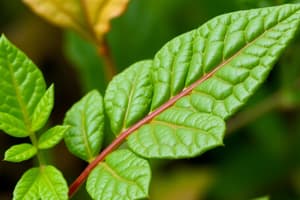Podcast
Questions and Answers
Which aspect of life science is MOST directly involved in creating drought-resistant crops?
Which aspect of life science is MOST directly involved in creating drought-resistant crops?
- Anatomy
- Zoology
- Marine Biology
- Biotechnology (correct)
The principle of homeostasis suggests that organisms always maintain a completely static internal environment, never allowing for any fluctuation.
The principle of homeostasis suggests that organisms always maintain a completely static internal environment, never allowing for any fluctuation.
False (B)
Describe how an understanding of microbial ecology could be applied to bioremediation efforts in a polluted aquatic ecosystem.
Describe how an understanding of microbial ecology could be applied to bioremediation efforts in a polluted aquatic ecosystem.
Understanding microbial ecology allows for the strategic selection or enhancement of microorganisms capable of degrading specific pollutants, optimizing bioremediation processes based on the ecosystem’s unique conditions.
The use of CRISPR-Cas9 technology to modify the genome of an organism falls under the umbrella of ______.
The use of CRISPR-Cas9 technology to modify the genome of an organism falls under the umbrella of ______.
Match the following tools/techniques with their primary application in life science research:
Match the following tools/techniques with their primary application in life science research:
Which of the following represents the MOST direct application of synthetic biology?
Which of the following represents the MOST direct application of synthetic biology?
The field of genomics primarily focuses on studying individual genes in isolation rather than the entire genetic complement of an organism.
The field of genomics primarily focuses on studying individual genes in isolation rather than the entire genetic complement of an organism.
Explain how the principles of ecology can inform strategies for managing invasive species in a national park.
Explain how the principles of ecology can inform strategies for managing invasive species in a national park.
The ability of the human body to maintain a stable internal temperature despite external environmental changes is an example of ______.
The ability of the human body to maintain a stable internal temperature despite external environmental changes is an example of ______.
Match the following scientists with their contribution to the field of life science:
Match the following scientists with their contribution to the field of life science:
Which of the following scenarios BEST illustrates the application of personalized medicine?
Which of the following scenarios BEST illustrates the application of personalized medicine?
Ecology primarily focuses on the internal physiological processes of individual organisms rather than their interactions with the environment.
Ecology primarily focuses on the internal physiological processes of individual organisms rather than their interactions with the environment.
Describe how advancements in DNA sequencing technology have transformed the field of forensic science.
Describe how advancements in DNA sequencing technology have transformed the field of forensic science.
The branch of life science that specifically studies the function and behavior of the nervous system is known as ______.
The branch of life science that specifically studies the function and behavior of the nervous system is known as ______.
Match the following technological advancements with their contribution to environmental science:
Match the following technological advancements with their contribution to environmental science:
Which of the following applications is MOST aligned with the goals of climate change biology?
Which of the following applications is MOST aligned with the goals of climate change biology?
Biochemistry is limited to studying only the chemical processes that occur within microorganisms, excluding larger and more complex organisms.
Biochemistry is limited to studying only the chemical processes that occur within microorganisms, excluding larger and more complex organisms.
Explain how the study of physiology contributes to our understanding and treatment of cardiovascular diseases.
Explain how the study of physiology contributes to our understanding and treatment of cardiovascular diseases.
The process by which traits are passed from parents to offspring, leading to similarities and differences among individuals, is called ______.
The process by which traits are passed from parents to offspring, leading to similarities and differences among individuals, is called ______.
Match the following microscopy techniques with their primary use in visualizing biological samples:
Match the following microscopy techniques with their primary use in visualizing biological samples:
Flashcards
Life Science
Life Science
The scientific study of living organisms and life processes.
Biology
Biology
The study of life, covering microbes to ecosystems.
Biotechnology
Biotechnology
Using biological systems to create new technologies and products.
Zoology
Zoology
Signup and view all the flashcards
Botany
Botany
Signup and view all the flashcards
Ecology
Ecology
Signup and view all the flashcards
Genetics
Genetics
Signup and view all the flashcards
Microbiology
Microbiology
Signup and view all the flashcards
Biochemistry
Biochemistry
Signup and view all the flashcards
Physiology
Physiology
Signup and view all the flashcards
Anatomy
Anatomy
Signup and view all the flashcards
Marine Biology
Marine Biology
Signup and view all the flashcards
Environmental Science
Environmental Science
Signup and view all the flashcards
Cell Theory
Cell Theory
Signup and view all the flashcards
Evolution
Evolution
Signup and view all the flashcards
Genetics and Heredity
Genetics and Heredity
Signup and view all the flashcards
Homeostasis
Homeostasis
Signup and view all the flashcards
Energy and Metabolism
Energy and Metabolism
Signup and view all the flashcards
Ecology and Ecosystems
Ecology and Ecosystems
Signup and view all the flashcards
Microscopy
Microscopy
Signup and view all the flashcards
Study Notes
- Life science encompasses the scientific study of living organisms and life processes
- It includes a wide range of disciplines that explore the structure, function, growth, origin, evolution, distribution, and taxonomy of living organisms
Branches of Life Science
- Biology: The overarching study of life, covering everything from the smallest microbes to the largest ecosystems
- Includes sub-disciplines like botany (plants), zoology (animals), and microbiology (microorganisms)
- Biotechnology: Exploits biological systems to create new technologies and products
- Applications span medicine, agriculture, and environmental science
- Zoology: Focuses specifically on the study of animals
- Covers animal anatomy, physiology, behavior, and evolution
- Botany: Dedicated to the study of plants
- Includes plant physiology, genetics, ecology, distribution, classification, and economic importance
- Ecology: Examines the interactions between organisms and their environment
- Studies ecosystems, communities, and populations
- Genetics: Studies heredity and variation in living organisms
- Includes the structure, function, and inheritance of genes
- Microbiology: Focuses on microorganisms such as bacteria, viruses, fungi, and protozoa
- Includes their structure, function, and roles in various processes (e.g., disease, decomposition)
- Biochemistry: Investigates the chemical processes within and relating to living organisms
- Focuses on the structure and function of biomolecules such as proteins, carbohydrates, lipids, and nucleic acids
- Physiology: Studies the functions and mechanisms of living organisms and their parts
- Explores how organisms carry out physical and chemical functions
- Anatomy: Deals with the structural organization of living organisms
- Includes both macroscopic (gross anatomy) and microscopic anatomy (histology)
- Marine Biology: The exploration of life in oceans and other marine environments
- It includes the study of marine organisms, their behaviors, and their interactions with the environment
- Environmental Science: An interdisciplinary field that integrates biological, physical, and information sciences to study the environment and solve environmental problems
- Focuses on the impact of human activities on the environment
Core Concepts in Life Science
- Cell Theory: All living organisms are composed of cells, the basic structural and functional units of life
- All cells arise from pre-existing cells
- Evolution: The process by which populations of organisms change over time
- Key mechanisms include natural selection, genetic drift, mutation, and gene flow
- Genetics and Heredity: Traits are passed from parents to offspring through genes
- Genes are made of DNA and encode instructions for building proteins
- Homeostasis: The ability of an organism to maintain a stable internal environment despite changes in external conditions
- Involves regulatory mechanisms such as feedback loops
- Energy and Metabolism: All living organisms require energy to carry out life processes
- Metabolism includes all the chemical reactions that occur within an organism, including catabolism (breaking down molecules) and anabolism (building molecules)
- Ecology and Ecosystems: Organisms interact with each other and their environment in complex ways
- Ecosystems include all the living organisms in a particular area, as well as the non-living components of the environment
Importance of Life Science
- Medicine and Healthcare: Understanding biology is crucial for developing new treatments for diseases and improving human health
- Includes the development of new drugs, therapies, and diagnostic tools
- Agriculture: Life science principles are used to improve crop yields, develop pest-resistant crops, and enhance livestock production
- Includes genetic engineering, selective breeding, and sustainable farming practices
- Environmental Conservation: Studying ecology and environmental science helps us understand how to protect biodiversity, conserve natural resources, and mitigate environmental problems
- Includes efforts to reduce pollution, protect endangered species, and conserve habitats
- Biotechnology: Life science drives innovation in biotechnology, leading to new products and technologies in medicine, agriculture, and industry
- Includes the development of biofuels, bioplastics, and genetically modified organisms
- Understanding Ourselves: Life science helps us understand our own bodies, behaviors, and place in the natural world
- Includes understanding human evolution, genetics, and physiology
Tools and Techniques
- Microscopy: Used to visualize cells, tissues, and microorganisms at different magnifications
- Includes light microscopy, electron microscopy, and fluorescence microscopy
- DNA Sequencing: Used to determine the order of nucleotides in a DNA molecule
- Essential for genetic research, medical diagnostics, and forensic science
- Cell Culture: Growing cells in a controlled environment outside of their natural context
- Used for research, drug development, and tissue engineering
- Genetic Engineering: Modifying the genetic material of an organism
- Includes techniques such as gene cloning, gene editing (e.g., CRISPR), and transformation
- Statistical Analysis: Used to analyze biological data and draw conclusions
- Essential for experimental design and data interpretation
- Imaging Techniques: Includes X-rays, MRIs, and CT scans for visualizing internal structures
- Used in medical diagnostics and research
- Chromatography and Spectrometry: Used to separate and analyze molecules based on their physical and chemical properties
- Used in biochemistry, environmental science, and forensic science
Impact on Society
- Ethical Considerations: Life science raises important ethical questions about topics such as genetic engineering, cloning, and the use of animals in research
- Requires careful consideration of the potential benefits and risks of new technologies
- Public Health: Life science research informs public health policies and practices
- Includes efforts to prevent and control infectious diseases, promote healthy lifestyles, and address environmental health hazards
- Economic Development: Life science industries contribute to economic growth by creating jobs and developing new products and technologies
- Includes the pharmaceutical, biotechnology, and agricultural sectors
- Education: Life science education is essential for preparing students for careers in science, medicine, and technology
- Includes fostering scientific literacy and critical thinking skills
Current Research Areas
- Genomics: Studying the entire genome of an organism
- Includes identifying genes, understanding gene function, and exploring genetic variation
- Personalized Medicine: Tailoring medical treatment to the individual characteristics of each patient
- Includes using genetic information to predict drug response and disease risk
- Synthetic Biology: Designing and building new biological parts, devices, and systems
- Includes creating artificial cells, engineering metabolic pathways, and developing new biomaterials
- Neurobiology: Studying the nervous system and brain
- Includes understanding brain function, neural development, and neurological disorders
- Cancer Biology: Studying the causes, mechanisms, and treatments of cancer
- Includes developing new therapies and diagnostic tools
- Immunology: Studying the immune system and its response to pathogens and other threats
- Includes developing vaccines, therapies for autoimmune diseases, and strategies to enhance immune function
- Climate Change Biology: Studying the impacts of climate change on living organisms and ecosystems
- Includes understanding species responses to climate change, predicting future impacts, and developing strategies for conservation and mitigation
Studying That Suits You
Use AI to generate personalized quizzes and flashcards to suit your learning preferences.




